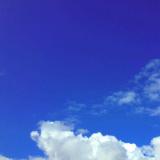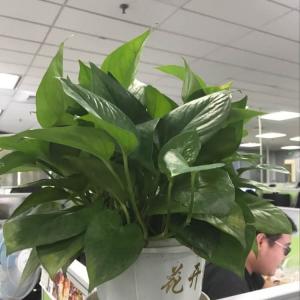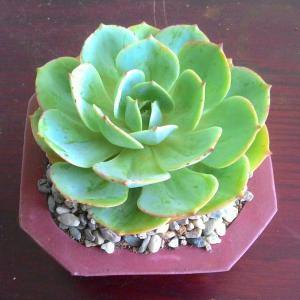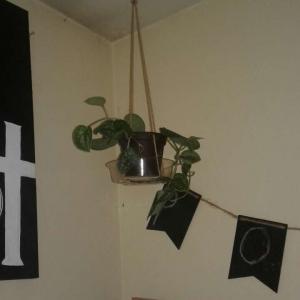文章
Dummer. ゛☀
2017年09月19日

Dischidia is a genus of some 80 species of trailing, twining or scandent, succulent epiphytes found throughout the tropics of Asia (New Guinea, Moluccas, Philippines, India, tropical Australia, Hong Kong, Taiwan) through to the western Pacific.
Dischidia are plants that grow on supports such as tree trunks or branches. Their stems may produce roots along the nodes to absorb nutrients and water and provide additional support for the plant. Dischidia are some of the easiest and most rewarding plants to grow! They tolerate wide variations in temperature and humidity. A very succulent species with grey/yellow/green colored foliage depending on light exposure. The foliage is also somewhat variable depending upon culture. A quick grower for drier areas of the terrarium and excellent in hanging baskets for home and garden!
Growing Conditions
Light: Grow Dischidia in medium to bright light to keep the plant happy.
Water: Water Dischidia when the soil surface starts to dry. The plant is fairly drought tolerant, so you don’t need to be alarmed if you forget to water it now and again.
USDA Hardiness Zone: 10 and 11.
Soil: Plant your Dischidia in a loose, well-draining soil designed for epiphytic plants; it is usually composed of coconut husk or shredded bark.
Grower’s Tips
Allow the soil to dry out before you water the plant. They are used to getting moisture only from dew and the air, and cannot tolerate boggy media. When the bark medium is dry to the touch, submerge the container in water until air bubbles are gone.
Dischidia also needs high humidity. Mist the plant every day or place the container on a saucer filled with pebbles and water. The water will evaporate and moisten the air while the pebbles will hold the sensitive roots out of the water.
Dischidia doesn’t really need fertilizer but you should change the planting media every year. If you wish, apply a diluted by half liquid plant food when you water beginning in spring and stopping by September.

Dischidia are plants that grow on supports such as tree trunks or branches. Their stems may produce roots along the nodes to absorb nutrients and water and provide additional support for the plant. Dischidia are some of the easiest and most rewarding plants to grow! They tolerate wide variations in temperature and humidity. A very succulent species with grey/yellow/green colored foliage depending on light exposure. The foliage is also somewhat variable depending upon culture. A quick grower for drier areas of the terrarium and excellent in hanging baskets for home and garden!

Growing Conditions
Light: Grow Dischidia in medium to bright light to keep the plant happy.
Water: Water Dischidia when the soil surface starts to dry. The plant is fairly drought tolerant, so you don’t need to be alarmed if you forget to water it now and again.
USDA Hardiness Zone: 10 and 11.
Soil: Plant your Dischidia in a loose, well-draining soil designed for epiphytic plants; it is usually composed of coconut husk or shredded bark.

Grower’s Tips
Allow the soil to dry out before you water the plant. They are used to getting moisture only from dew and the air, and cannot tolerate boggy media. When the bark medium is dry to the touch, submerge the container in water until air bubbles are gone.
Dischidia also needs high humidity. Mist the plant every day or place the container on a saucer filled with pebbles and water. The water will evaporate and moisten the air while the pebbles will hold the sensitive roots out of the water.

Dischidia doesn’t really need fertilizer but you should change the planting media every year. If you wish, apply a diluted by half liquid plant food when you water beginning in spring and stopping by September.
1
1
文章
Dummer. ゛☀
2017年09月19日

Sycamore anthracnose is a fungal disease that can cause leaf drop, twig dieback, cankers and the sudden death of more than 90% of a tree’s new shoot growth. Although the disease is rarely fatal and trees will grow a second set of leaves, repeat infections will result in abnormal branching and will leave a tree stressed and more susceptible to other diseases and pests. American sycamore or buttonwood (Platanus occidentalis), London plane tree (P. x acerifolia) and Oriental plane tree (P. orientalis) may all be affected by sycamore anthracnose.
Symptoms and Diagnosis
Sycamore anthracnose is most common during the cool wet weather of spring and is often mistaken for frost damage. As new leaves unfold, they crinkle and turn brown, wilt rapidly and fall. Dark and sunken dead areas form along the veins of older leaves eventually expanding to include the entire leaf. The tree may also develop cankers on twigs and older branches resulting in twig dieback and the girdling and death of the larger branches. Small black dots, the fruiting bodies of the fungus, may be visible. The clusters of dead twigs will result in abnormal branching such as witches’ brooms or as the twigs die, break and fall, the tree will appear ragged. Reportedly, London plane tree is less susceptible to cankers than the American sycamore.
Life Cycle
The sycamore anthracnose fungus, Apiognomonia veneta, overwinters in diseased leaves and in cankers on twigs and branches. Spores are produced in spring and spread by rain. If the mean daily temperatures are 50 – 55 degrees F., the spores will germinate and the resulting infections will cause the death of new buds, shoots and leaves. The disease will be slight or will not occur by late spring or midsummer when the mean daily temperatures are 60 degrees F. or greater and the tree will be able to produce a second set of leaves. The fungus may also infect twigs and buds in fall after leaf drop.
Integrated Pest Management Strategies
1. Be patient. The tree may appear to be dead but will probably recover and develop new leaves and shoots.
2. Practice good garden sanitation by raking up and disposing of fallen leaves and twigs.
3. Practice good cultural techniques to keep plants healthy and free of drought, nutritional or injury-induced stress. Water trees twice a month during dry winters.
4. Prune out dead branches when possible. Disinfect pruning shears in a 10% bleach solution between cuts to avoid spreading the disease.
5. Prune branches to improve air circulation reducing the length of time leaves are wet and thus susceptible to infection.
6. Treat with a preventive systemic fungicide. This treatment may require the services of a certified arborist.
7. Spray with a preventive fungicide such as lime-sulfur (Bordeaux mixture) or chlorothalonil (daconil) when leaves begin to emerge from buds. Reapply two or three more times at 7-10 day intervals. Fungicides are not effective after the leaves have been infected. Large trees may require the services of a certified arborist.
8. Plant resistant species or cultivars. Oriental plane tree (zones 7-9) and London plane tree cultivars, ‘Bloodgood’, ‘Columbia’ and ‘Liberty’ are less susceptible to the disease than the American sycamore.

Symptoms and Diagnosis
Sycamore anthracnose is most common during the cool wet weather of spring and is often mistaken for frost damage. As new leaves unfold, they crinkle and turn brown, wilt rapidly and fall. Dark and sunken dead areas form along the veins of older leaves eventually expanding to include the entire leaf. The tree may also develop cankers on twigs and older branches resulting in twig dieback and the girdling and death of the larger branches. Small black dots, the fruiting bodies of the fungus, may be visible. The clusters of dead twigs will result in abnormal branching such as witches’ brooms or as the twigs die, break and fall, the tree will appear ragged. Reportedly, London plane tree is less susceptible to cankers than the American sycamore.

Life Cycle
The sycamore anthracnose fungus, Apiognomonia veneta, overwinters in diseased leaves and in cankers on twigs and branches. Spores are produced in spring and spread by rain. If the mean daily temperatures are 50 – 55 degrees F., the spores will germinate and the resulting infections will cause the death of new buds, shoots and leaves. The disease will be slight or will not occur by late spring or midsummer when the mean daily temperatures are 60 degrees F. or greater and the tree will be able to produce a second set of leaves. The fungus may also infect twigs and buds in fall after leaf drop.

Integrated Pest Management Strategies
1. Be patient. The tree may appear to be dead but will probably recover and develop new leaves and shoots.
2. Practice good garden sanitation by raking up and disposing of fallen leaves and twigs.
3. Practice good cultural techniques to keep plants healthy and free of drought, nutritional or injury-induced stress. Water trees twice a month during dry winters.
4. Prune out dead branches when possible. Disinfect pruning shears in a 10% bleach solution between cuts to avoid spreading the disease.
5. Prune branches to improve air circulation reducing the length of time leaves are wet and thus susceptible to infection.

6. Treat with a preventive systemic fungicide. This treatment may require the services of a certified arborist.
7. Spray with a preventive fungicide such as lime-sulfur (Bordeaux mixture) or chlorothalonil (daconil) when leaves begin to emerge from buds. Reapply two or three more times at 7-10 day intervals. Fungicides are not effective after the leaves have been infected. Large trees may require the services of a certified arborist.
8. Plant resistant species or cultivars. Oriental plane tree (zones 7-9) and London plane tree cultivars, ‘Bloodgood’, ‘Columbia’ and ‘Liberty’ are less susceptible to the disease than the American sycamore.
0
0
成长记
Wendy F. Samonte
2017年09月19日
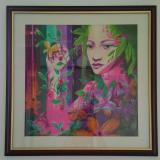
I new added a "Black Prince" in my "garden"
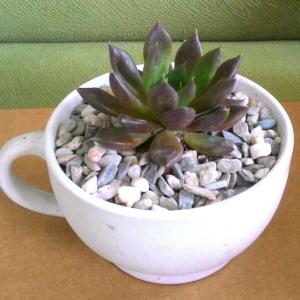

3
0
Fancy Loo:要常晒太阳喔
Summer:cool









